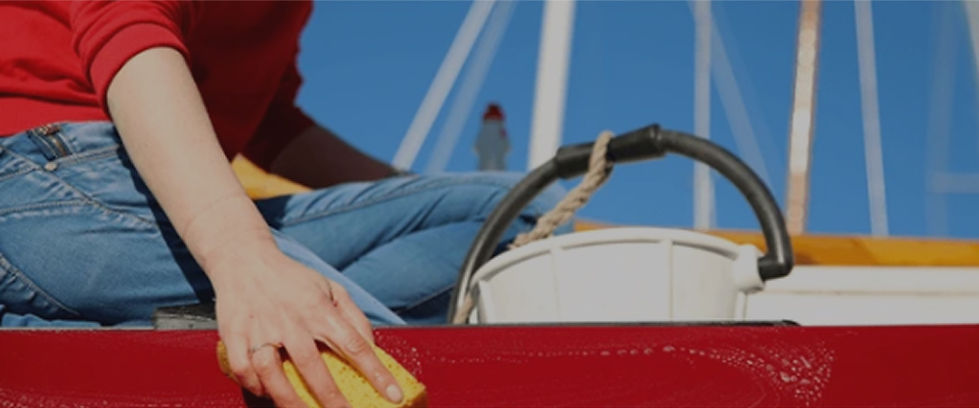
Maintaining your Boat Canvas
Maintaining a boat isn't just about aesthetics. Neglect can lead to more than just an unsightly vessel. While most marine hardware is built to endure the elements, accumulated dirt, dust, and standing water can cause damage beyond just appearance. Many boaters use canvas covers to shield their boats from rain, dirt, and droppings. However, while canvas protects your boat, it also requires regular care to remain effective. If neglected, it can lose its water-repelling properties, leading to unwanted leaks and exposure to the very elements it's meant to block. Fortunately, maintaining your canvas is easier than you might think.
Quick Cleanups
Cleaning canvas is simple but requires the right approach. High-pressure washers and harsh household cleaners might seem effective but can harm the fabric. The best method is to first remove loose dirt, bird droppings, and bug residue using a dry rag or a soft brush. Addressing messes immediately is crucial, as they can leave stubborn stains over time. For tougher spots, a slightly damp cloth may be needed, but scrubbing too hard can grind dirt into the material.
Deep Clean
For deeper stains, mild soaps like Woolite or Dawn work well. However, some detergents can strip the canvas of its protective coatings, so always check the manufacturer’s recommendations. Specialized canvas cleaners, such as those from Starbright or Marine 31 are also an option. Your local West Marine can provide recommendations based on your unique situation.
The cleaning process is straightforward:
-
Start by thoroughly soaking the canvas with fresh water—avoid pressure washers, as they can damage the fabric. A garden hose is ideal for ensuring full saturation.
-
Pay extra attention to seams where material overlaps.
-
Gently scrub the fabric using a soft-bristle brush and mild soap, allowing the solution to sit for several minutes to break down grime.
-
After soaking, scrub again lightly, then rinse thoroughly.
-
Repeat as needed until the canvas is fully clean.
Reconditioning & Waterproofing
Regular cleaning helps extend the life of canvas, but over time, its protective coatings wear down, requiring reproofing. Products like 303 Marine Fabric Guard restore water and stain resistance, preventing mold growth and deterioration.
Reproofing is best done after cleaning and drying the canvas. Most products should not be applied in direct sunlight while curing. The process is simple:
-
Use a spray bottle to apply an even layer of reproofed.
-
For hard-to-reach areas, use a brush or roller.
-
Multiple light coats work better than one heavy application.
With proper maintenance, your boat’s canvas can last for years. While caring for it requires some effort, it’s far better than replacing a cover—or dealing with a mess of bird droppings. In fact, after enough time invested, you might even find yourself wanting a cover for your boat cover!
Eisenglass Maintenance
-
When you aren’t using your boat, remember to keep your canvas snapped into place. This helps to slow down shrinkage and also keeps your vinyl wrinkle free.
-
Clear vinyl can easily burn when lying against metal bimini top legs. You can prevent this by using bimini stand offs or bimini sox’s.
-
Rolling up clear vinyl enclosure panels is hard on the panels, but leaving them rolled up for extended periods of time can permanently damage the vinyl. This happens when water gets trapped in the rolls and clouds the vinyl. Most of the time the clouding disappears, but occasionally this is permanent.
-
Before rolling up and securing your enclosure panel, try using a towel-wrapped dry pool noodle to roll the plastic onto. This helps keep the vinyl from creasing and sagging in warm weather.
-
Store your boat enclosure panels clean and dry with towels or sheets between them. If you can’t store them flat, try rolling them up onto 3 towel-wrapped dry pool noodles. This keeps them from collapsing and creasing. Creases in the vinyl can actually crack when an attempt is made to straighten them out during cold weather.
-
Indentations caused by storage will usually come out of the plastic over time.
-
Burns, UV degradation, and scratches cannot be removed from clear vinyl. Light scratches can be improved, but never fully removed.
-
If you just can’t stand looking through that old vinyl any more, maybe you should consider having your clear vinyl replaced. As long as the snaps, fabric, and zippers are still in decent condition, it’s a less expensive solution than replacing the entire enclosure.
-
When cleaning your eisenglass, use products designed for the job. Imar, 210, and Davies Klear to Sea are good choices. Steer clear of Coleman fuel, Rain-X, and other products not designed for the job. Good, light scratch removers are Novus, Imar and Meguires.
-
Be very careful when cleaning your boat with chemicals. Splashing can cause damage to clear vinyls.
Click the link below to visit Sunbrella’s website for additional information on care and maintenance for your canvas and outdoor fabrics.



